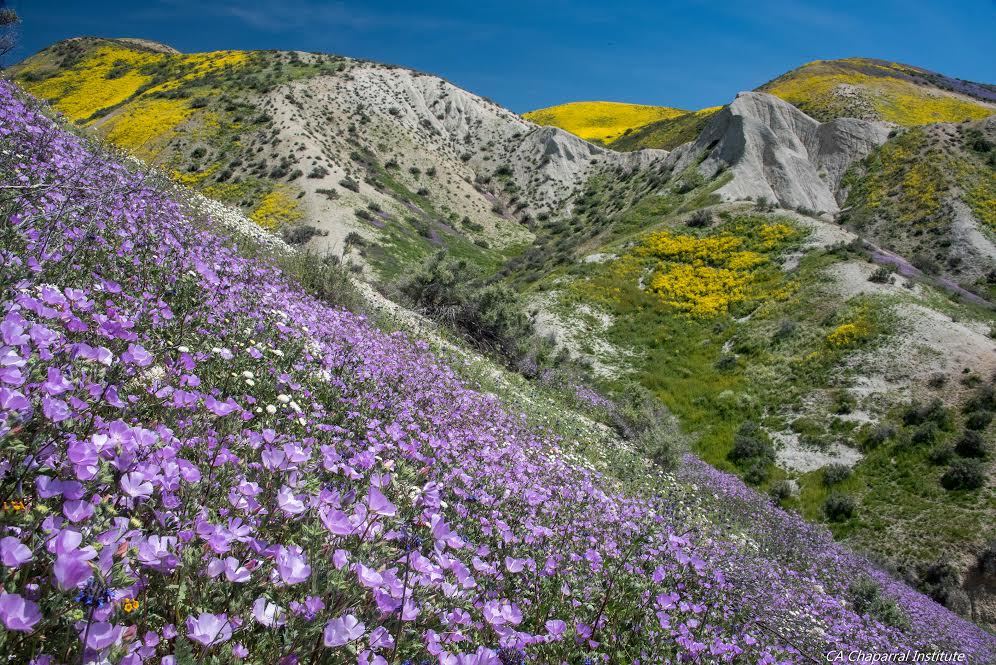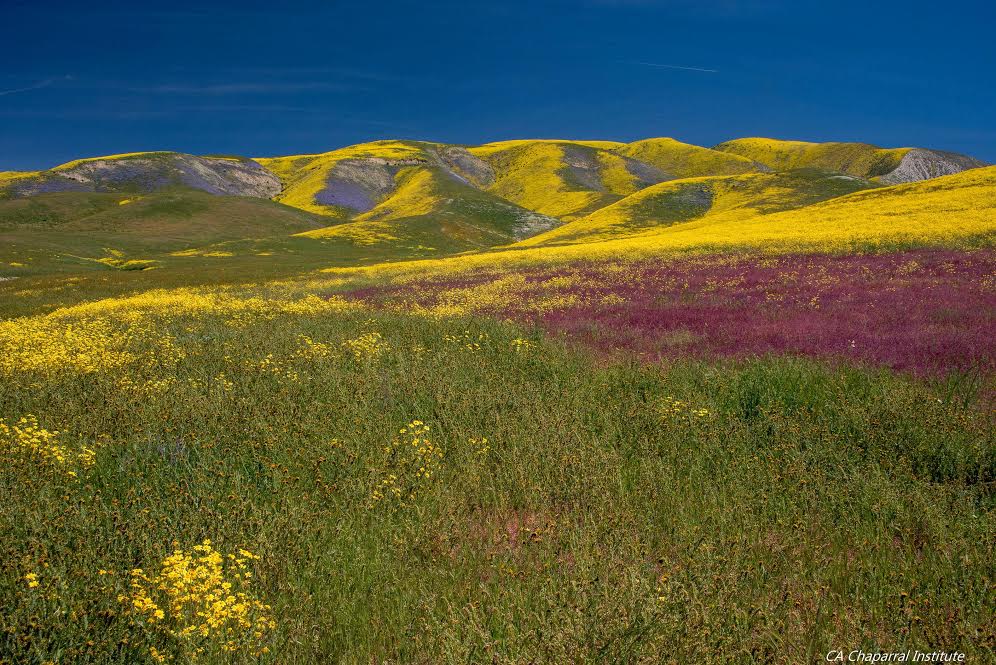Carrizo Plain National Monument threatened
April 26, 2017

The watercolor palate of native wildflower colors, the purple, the orange, the yellow, the blue, was stunning this year. Photo courtesy of the California Chaparral Institute.
By KAREN VELIE
President Donald Trump on Wednesday ordered a review of two dozen national monuments that could end protections against mining, logging and oil drilling. Trumps executive order could put the Carrizo Plain National Monument in San Luis Obispo County up for reconsideration.
Under the 1906 Antiquities Act, either Congress or the president can protect federal lands by designating them as a national monument. In 2001, President Bill Clinton declared the Carrizo Plain a national monument.
“The Antiquities Act does not give the federal government unlimited power to lock up millions of acres of land and water, and it’s time that we ended this abusive practice,” Trump declared.
Trump’s order instructs Interior Secretary Ryan Zinke to review all national monuments that make up 100,000 acres or more, and were created by presidential proclamation since 1996. The Carrizo Plain spans 204,107 acres.

The Carrizo Plain’s version of Half Dome with Parry’s mallow (Eremalche parryi) in the foreground. Photo courtesy of the California Chaparral Institute.
Environmental groups have announced plans to battle to protect the Carrizo Plain National Monument.
“Today’s Executive Order is an attack on public lands and an affront to millions of Americans who live, work, and play in these spectacular landscapes,” said Jeff Kuyper, executive director of Los Padres ForestWatch, a nonprofit conservation organization dedicated to protecting the Carrizo Plain National Monument and the adjacent Los Padres National Forest. “We stand ready to defend the Carrizo Plain National Monument from any misguided efforts that would make these lands more vulnerable to development.”
The Carrizo Plain National Monument is a vast expanse of golden grasslands and stark ridges which recently attracted thousands of visitors to a “super bloom” of wildflowers. Often referred to as “California’s Serengeti,” the Carrizo Plain is one of the last undeveloped remnants of the southern San Joaquin Valley ecosystem.
“Our national monuments are part of what makes America great,” Kuyper said. “With the support of the community behind us, we’re ready to do whatever it takes to preserve this unique landscape for current and future generations to enjoy.”

Everywhere, awash in color! The pink swash on the right is filled with the drying seed cases of shiny pepper grass (Lepidium nitidum). Photo courtesy of the California Chaparral Institute.
The White House released a list of the 24 national monuments up for reconsideration on Wednesday. They are:
· Carrizo Plain National Monument in California, proclaimed by Clinton in 2001 (204,107 acres).
· Giant Sequoia National Monument in California, proclaimed by Clinton in 2000 (327,769 acres).
· Sand to Snow National Monument in California, proclaimed by Obama in 2016 (154,000 acres).
· Berryessa Snow Mountain in California, proclaimed by Obama in 2015 (330,780 acres).
· Mojave Trails National Monument in California, proclaimed by Obama in 2016 (1.6 million acres).
· World War II Valor in the Pacific National Monument in California, Hawaii and Alaska, proclaimed by Bush in 2008 (4 million acres).
· Grand Staircase-Escalante National Monument in Utah, proclaimed by President Clinton in 1996. (1.7 million acres).
· Grand Canyon-Parashant National Monument in Arizona, proclaimed by Clinton in 2000 (1 million acres).
· Vermilion Cliffs National Monument in Arizona, proclaimed by Clinton in 2000 (279,568 acres).
· Hanford Reach National Monument in Washington, proclaimed by Clinton in 2000 (194,450 acres).
· Canyons of the Ancients National Monument in Colorado, proclaimed by Clinton in 2000 (175,160 acres).
· Ironwood Forest National Monument in Arizona, proclaimed by Clinton in 2000 (128,917 acres).
· Sonoran Desert National Monument in Arizona, proclaimed by Clinton in 2001 (486,149 acres).
· Upper Missouri River Breaks National Monument in Montana, proclaimed by Clinton in 2001 (377,346 acres).
· Papahanaumokuakea Marine National Monument in the Pacific Ocean, proclaimed by President George W. Bush in 2006 and expanded by President Barack Obama in 2016, (89.6 million acres).
· Marianas Trench Marine National Monument in the Pacific Ocean, proclaimed by Bush in 2009 (60.9 million acres).
· Pacific Remote Islands Marine National Monument in the Pacific Ocean, proclaimed by Bush in 2009 and enlarged by Obama in 2014. (55.6 million acres).
· Rose Atoll Marine National Monument in American Samoa, proclaimed by Bush in 2009 (8.6 million acres).
· Rio Grande del Norte National Monument in New Mexico, proclaimed by Obama in 2013. (242,555 acres).
· Organ Mountains-Desert Peaks National Monument in New Mexico, proclaimed by Obama in 2014 (496,330 acres).
· Basin and Range National Monument in Nevada, proclaimed by Obama in 2015 (703,585 acres).
· Northeast Canyons & Seamounts Marine National Monument in the Atlantic Ocean, proclaimed by Obama in 2016 (3.1 million acres).
· Bears Ears National Monument in Utah, proclaimed by Obama in 2016 (1.4 million acres).
· Gold Butte National Monument in Nevada, proclaimed by Obama in 2016 (296,937 acres).






The comments below represent the opinion of the writer and do not represent the views or policies of CalCoastNews.com. Please address the Policies, events and arguments, not the person. Constructive debate is good; mockery, taunting, and name calling is not. Comment Guidelines